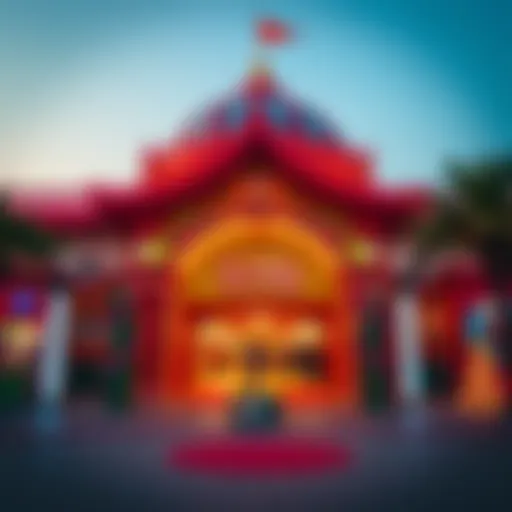Architectural Insights into Abdullah Al Shaiba Tower
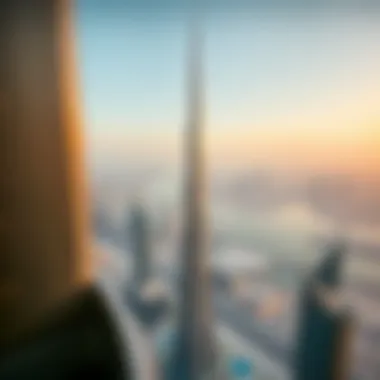
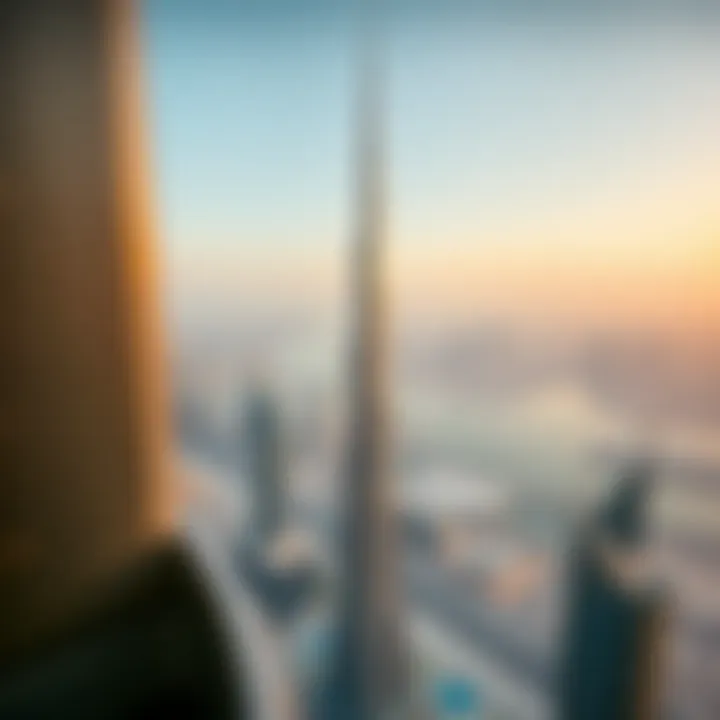
Market Insights
Current Trends in Dubai Real Estate
Dubai’s real estate market has seen ebbs and flows, but as of late, it has exposed its resilience and adaptability. The spotlight has shifted as urbanization continues to shape the landscape, and new marvels like the Abdullah Al Shaiba Tower become focal points for discussions around investment and architectural significance. Here are some key trends:
- Luxury Demand: High-end properties have flourished as affluent expatriates and investors look for gated communities and opulent apartments. This trend aligns well with what the Abdullah Al Shaiba Tower offers, given its prime location and exquisite design.
- Tech Integration: Properties now boast smart technologies to attract tech-savvy buyers. This is a crucial area where innovative towers, including Abdullah Al Shaiba, intersect with buyers' preferences.
- Sustainability Focus: We are witnessing a shift towards sustainable building practices. Investors are keen on properties that incorporate eco-friendly materials and energy-efficient technologies. The architectural framework of Abdullah Al Shaiba Tower emphasizes this trend through its modern infrastructure.
Predictive Analysis of Future Developments
The real estate landscape is ever-evolving, influenced by both local and global factors. The future of developments in Dubai looks promising, bolstered by several projected trends:
- Increase in Population: As more people flock to Dubai seeking employment and residency, the demand for housing will inevitably rise. The Abdullah Al Shaiba Tower, as a pivotal structure, is perfectly positioned to cater to this broader demographic.
- Government Initiatives: The Dubai government is heavily investing in infrastructure and promoting foreign investments through attractive incentives, which is likely to bolster sales in high-profile developments like the tower.
- Cultural Integration: The ongoing efforts to blend modernity with heritage means that buildings that reflect Dubai's diverse culture will gain more favor among buyers and tourists. The design of Abdullah Al Shaiba Tower resonates with this cultural essence and can appeal to a broader audience.
"The future looks bright, with real estate retaining its stronghold as a reliable investment avenue in Dubai."
This insight into the market trends and future forecasts provides a valuable context for understanding the significance of Abdullah Al Shaiba Tower in this thriving metropolis.
Prelude to Abdullah Al Shaiba Tower
The Abdullah Al Shaiba Tower stands tall as a beacon of architectural ambition in Dubai, representing not only modern design but also a statement about the city's real estate evolution. This section aims to dive into the significance of this towering structure, setting the stage for a broader discussion on its architectural and cultural gravitas.
Location and Overview
Situated in the heart of Dubai's dynamic landscape, the Abdullah Al Shaiba Tower has become synonymous with the city’s skyline transformation. Its location—central yet distinct—shows a deliberate choice to harmonize with Dubai’s urban fabric while making a statement of its own. The juxtaposition of the tower against the backdrop of traditional and contemporary structures speaks volumes about the city's ethos, embodying a fusion of innovation and heritage.
Visitors can easily access this landmark via major arterial roads, making it a focal point for both tourists and residents. The area resembles a bustling hive of activity, with shops, cafés, and residential complexes, creating a lively environment surrounding the tower. This not only enhances its visibility but also amplifies its role as a community landmark.
The Tower's Place in Dubai's Real Estate Market
In the ever-fluctuating landscape of Dubai's real estate market, the Abdullah Al Shaiba Tower carves out its niche with a blend of residential and commercial spaces, appealing to a wide audience from expatriates to investors. The tower signifies a commitment to high-end living through its strategic design, incorporating amenities and environments that meet contemporary demands. Such features are crucial as the market continues to evolve, drawing both local and international attention.
As an investment prospect, the tower offers potential returns that reflect Dubai's growth trajectory. Observers note that properties in proximity to iconic landmarks often appreciate in value, and Abdullah Al Shaiba Tower is poised to follow this trend. Furthermore, its architectural significance adds to its desirability, as discerning buyers often seek distinctive structures that resonate with their aspirations for luxury and lifestyle.
Understanding the architectural significance of Abdullah Al Shaiba Tower is critical for anyone looking to navigate Dubai's competitive real estate realm. Its design represents a bridge between traditional aesthetics and modern functionality, making it a touchstone for future developments.
The unique aspects of the tower's design, location, and potential investment value create a compelling narrative for stakeholders engaged in the city's real estate sector. As we explore further, these themes will uncover how Abdullah Al Shaiba Tower is not solely a physical structure, but rather a pivotal element in shaping Dubai's identity.
Architectural Design of the Tower
The architectural design of the Abdullah Al Shaiba Tower stands as a testament to the complex interplay of aesthetics and functionality in modern urban landscapes. As a significant landmark in Dubai's skyline, its design is more than just a mere structural entity; it serves a deeper purpose that resonates with the cultural and economic heartbeat of the city. This section explores critical elements of the tower's design, shedding light on its inspiration, material choices, and the sustainable practices integrated into its construction.
Design Concepts and Inspiration
The design of the Abdullah Al Shaiba Tower draws heavily from the rich cultural tapestry and architectural heritage of Dubai. Its form echoes traditional Islamic motifs, often visible in the intricate patterns that adorn its façade. This convergence of modernity and heritage is not merely for show but connects the tower to the historical narrative of the region.
- Key concepts include:
- Fluidity of Form: The tower boasts a sweeping silhouette that mimics the gentle curves of the surrounding desert dunes. This design choice is symbolic, portraying Dubai as a city that embraces its natural environment.
- Cultural Reflection: The integration of local artistic elements into the design establishes a dialogue between past and present, linking the structure to the communal identity of Dubai’s residents.
As architects often say, good design shouldn’t just look pretty; it should also feel right. The tower's design aims to create harmony, offering both visual pleasure and practical usage for its occupants. In a nutshell, Abdullah Al Shaiba Tower is not only a piece of architecture but also a narrative, inviting individuals to engage with its layers of meaning.
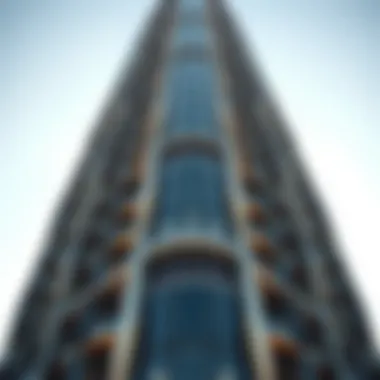
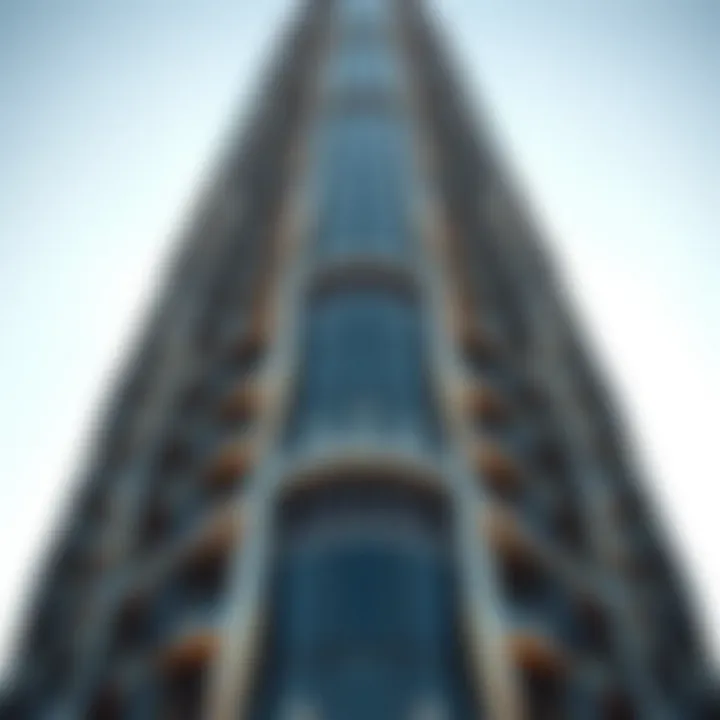
Materials and Techniques Used
The selection of materials and construction techniques used in the Abdullah Al Shaiba Tower reflects an advanced understanding of both local context and modern architecture standards. The choice of materials goes beyond aesthetics; it speaks volumes about durability and sustainability.
- Notable materials include:
- Reinforced Concrete: Known for its longevity, it provides a solid foundation while being versatile in form.
- Glass Facades: Panoramic views through high-performance glass panels are as much about allowing natural light into the building as they are about creating a dialogue with the city's skyline.
- Local Stone: Incorporating traditional materials honors the architectural legacy of the region and ensures the building blends with its surroundings.
Techniques used in the construction also showcase innovation:
- Modular Construction: This allows swift assembly and minimizes waste, aligning with modern efficiency standards.
- Advanced Building Information Modeling (BIM): This technique ensures precision in design and helps maintain project timelines, keeping the overall project on track.
These materials and techniques not only enhance the aesthetic quality of the tower but also emphasize resilience against the harsh desert climate, making it a practical choice for urban construction.
Sustainability Features
Today, sustainability forms the cornerstone of modern architectural practice, and the Abdullah Al Shaiba Tower is no exception. Its design integrates various sustainable features aimed at reducing ecological impact while ensuring comfort for inhabitants.
Some key sustainability features are:
- Green Roofs: These not only provide insulation but also support local biodiversity.
- Solar Panels: Installed to harness energy from the sun, they contribute significantly to the tower's energy needs, making it more self-sufficient.
- Water Recycling Systems: Employing greywater systems ensures water conservation and maximizes resource efficiency.
"The sustainability approach adopted by the architects encapsulates Dubai's vision of a greener future, where monumental structures can coexist harmoniously with the environment."
The integration of these features not only enhances the operational efficiency of the tower but also serves as a model for future developments in Dubai and beyond.
Through thoughtful design, material selection, and a commitment to sustainability, Abdullah Al Shaiba Tower stands as an exemplar of modern architecture, pushing boundaries while commemorating the cultural essence of Dubai.
Historical Context of the Tower
Understanding the historical context of the Abdullah Al Shaiba Tower is crucial to appreciate its architectural significance fully. This tower is not merely a structure but rather a testament to Dubai’s rapid transformation and its aspirations for the future. It reflects the city’s relentless pursuit of modernity and innovation while staying grounded in its rich cultural heritage.
Construction Timeline
The construction timeline of the Abdullah Al Shaiba Tower underscores the ambitious project management that characterizes Dubai’s building ventures. The groundbreaking ceremony took place in early 2017, setting into motion a series of meticulously planned phases aimed at completing the tower in record time. The actual rise of the structure began in mid-2018, with the construction team working around the clock to meet the projected completion date.
- 2017: Groundbreaking ceremony; initial groundwork begins.
- 2018: Above-ground construction begins, utilizing advanced engineering techniques to ensure stability in the tower’s unique design.
- 2020: Major structural components completed, transitioning into interior finishing.
- 2021: Final touches and preparations for official opening.
The building was inaugurated in 2021, and it became a defining feature of the Dubai skyline. As the tower rose, it faced the challenges typical in large-scale projects, including supply chain delays and regulatory requirements that demanded adherence to rigorous safety standards. Each of these factors played a role in shaping the final outcome of the tower's construction.
Historical Events Influencing Development
The development of the Abdullah Al Shaiba Tower cannot be discussed without acknowledging the broader historical events that influenced its design and construction. Dubai’s economic boom of the late 20th and early 21st centuries set the stage for such high-profile projects. Factors influencing this surge included:
- Globalization: With Dubai becoming a global business hub, the need for prominent structures that symbolize this status was undeniable.
- Real Estate Demand: Rising property values and an influx of expatriates fueled a robust real estate market, prompting the rapid development of luxury properties.
- Cultural Heritage: The architects drew inspiration from traditional Arabian motifs, blending them into a modern framework. This fusion reflects the city's rich culture while enhancing its cosmopolitan character.
- Technological Advancements: Innovations in construction technology allowed for the ambitious designs to become reality, enabling the tower to stand tall against environmental challenges such as wind and seismic activity.
In a city where the past meets the future, the Abdullah Al Shaiba Tower serves as a marker of how historical influences can shape contemporary architectural endeavors. It is a symbol not just of where Dubai has come from, but also of where it aims to go in the years ahead.
The Cultural Significance of the Tower
The Abdullah Al Shaiba Tower stands not merely as a high-rise structure in Dubai’s bustling skyline but also as a poignant symbol reflecting the intricate tapestry of culture and community. Understanding its cultural significance requires delving into how its design resonates with local traditions, values, and the modern identity of the city. This section aims to uncover the nuances of such symbolic representation within the architectural framework of the tower, exploring both aesthetic values and community-driven narratives.
Cultural Symbolism in Design
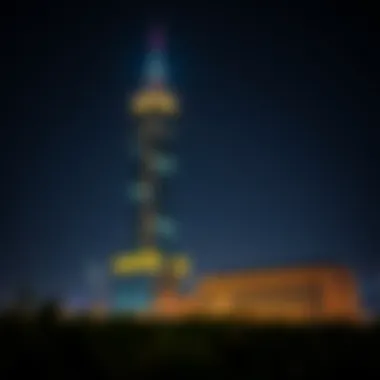
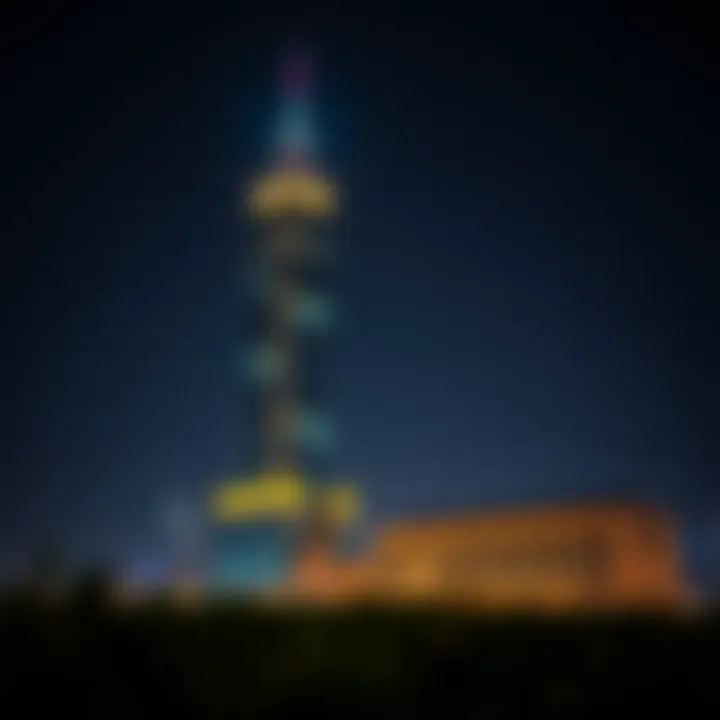
The architectural language of the Abdullah Al Shaiba Tower speaks volumes, weaving together modernity and tradition. The design incorporates elements that pay homage to Islamic art and Dubai’s rich heritage. For instance, intricate geometric patterns, often found in traditional Middle Eastern architecture, find their way into the tower’s facade. These elements are not just decorative; they evoke a sense of history and identity, bridging the gap between the past and a dynamic future.
Moreover, the use of local materials—sandstone and glass—reflects a commitment to sustainability while honoring regional resources. It showcases the unity of nature and constructed spaces, a theme deeply embedded in Dubai's architectural practice. This connection stands as a reminder to all observers of the resilience and adaptability intrinsic to Emirati culture.
"Architecture is the thoughtful making of space; it reflects a society’s values and aspirations.”
This quote encapsulates the essence of the cultural narrative surrounding the tower. By incorporating symbolic motifs that resonate with the community, the Abdullah Al Shaiba Tower transcends the ordinary, becoming a vessel of storytelling for generations to come.
Role in Community Identity
Beyond its role as a symbol, the Abdullah Al Shaiba Tower serves as a focal point for community identity. In a city that strives to fuse the rapid pace of urban development with the rich historical context, the tower stands as a testament to Dubai's evolution. It is not just about living spaces or commercial spaces; it integrates into the daily lives of residents and visitors.
The tower often plays host to community events, from art fairs that showcase local talent to cultural exhibitions that celebrate Emirati traditions. Such engagements are pivotal in reinforcing a shared identity among residents. They cultivate a sense of belonging that is essential in an increasingly globalized world.
The striking silhouette of the tower offers a geographic landmark for residents and tourists alike, contributing to a sense of place and belonging in Dubai. This relationship emphasizes not only the physical presence of the tower but also its artistic and emotional significance in the urban milieu.
In this ever-changing landscape, the Abdullah Al Shaiba Tower is more than an architectural feat; it’s a vivid reminder of communal heritage, identity, and continuity—elements that are crucial to both local inhabitants and visitors looking for a connection to the essence of Dubai.
Modern Relevance and Future Projections
Understanding the modern relevance and future projections of the Abdullah Al Shaiba Tower sheds light on its role within the fast-paced evolution of Dubai. This tower is not simply a structure; it is a symbol of ambition, innovation, and transformation. The significance of the tower emanates from its contribution to the changing landscape of Dubai, where modern architecture interacts with urban development to offer new possibilities and challenges.
Impact on Real Estate Landscape
The Abdullah Al Shaiba Tower serves as a critical pivot in the real estate environment of Dubai. As a standout architectural piece, it contributes to the overall aesthetic and functionality of the city. With its towering presence, the building has attracted both local and international attention, which in turn facilitates a more dynamic property market. Investors glance towards this iconic structure, not just because of its height or design; they see the attention it commands as a bellwether for real estate trends.
- Increased Foot Traffic: The tower draws visitors and potential tenants alike, which can stimulate business opportunities in surrounding areas.
- Cultural Hub: When combined with surrounding developments, the tower can help transform Dubai into a cultural destination. This can result in an increase in property demand for residential and commercial spaces.
- Urban Cohesion: Its strategic location and architectural significance can bridge various neighborhoods, fostering community ties and attracting more investors.
The tower is situated in a prime spot that encourages investment in nearby properties, enhancing the overall market value of the area. This ripple effect shows how the construction of a single edifice can catalyze an entire neighborhood’s growth, thus enriching the lifestyle and offering diverse amenities for residents.
Potential for Property Investment
For anyone eyeing investment opportunities, the Abdullah Al Shaiba Tower is undoubtedly worth serious consideration. With project pipelines booming across Dubai, it inherits an inherent potential that investors would do well to recognize:
- High Return on Investment: Due to its prominence, properties near or connected to the tower are likely going to appreciate over time, yielding higher returns as demand surges.
- Sustainable Developments: Following trends in sustainable architecture, future projects will likely align with environmentally friendly initiatives, making investments not only profitable but also socially responsible.
- Regulatory Framework: Dubai’s government actively encourages foreign investment with favorable policies, making the tower an enticing opportunity for overseas buyers.
- Market Diversification: Investors can diversify their portfolios by adding properties associated with the tower, which may include residential, commercial, or mixed-use developments.
Ending of Modern Relevance
In summary, the Abdullah Al Shaiba Tower is not just a feat of engineering but a landmark carrying immense architectural significance within one of the world’s most rapidly evolving cities. As the skyline of Dubai continues to rise, understanding the implications of this tower offers invaluable insights into the future of real estate and urban development in the emirate. With its unique position and the trends it sets, those poised to invest will find abundant opportunity in its shadow.
"A building is one of the most visible pieces in the real estate puzzle, influencing trends and shaping future investments."
For more information about investing in Dubai, you can visit Dubai Land Department.
Investors, homeowners, realtors, and analysts should maintain a keen eye on developments related to this exceptional tower, as it will undoubtedly play a pivotal role in shaping Dubai’s architectural legacy.
Comparative Analysis with Other Iconic Towers in Dubai
The exploration of the Abdullah Al Shaiba Tower cannot be complete without a comparative analysis with other iconic structures within Dubai. Such an examination is essential to draw connections and highlight architectural trends prevalent in this bustling metropolis. It is crucial for investors, homeowners, and architecture enthusiasts to understand how the Abdullah Al Shaiba Tower aligns or diverges from its renowned counterparts, both in design and functionality.
Similar Architectural Styles
When considering different towers in Dubai, one must note that various architectural styles tell a collective story about the city’s urban identity. For example, the Burj Khalifa’s vertical lines and sleek silhouette may be seen in the Abdullah Al Shaiba Tower’s design, reflecting a movement towards modernity while paying homage to traditional Islamic architecture. Both towers incorporate elements that respect cultural heritage while pushing the boundaries of contemporary engineering.
Another notable comparison could be drawn with the Jumeirah Beach Hotel Tower, famed for its wave-like structure. While quite distinct in its overall form, Abdullah Al Shaiba shares this creative boldness, suggesting a future where functional buildings echo the natural environment around them.


Specific characteristics shared between these towers include:
- Use of Glass Façades: Enhances natural light and reduces energy consumption.
- Equipped With Observation Decks: These features allow the public to admire the panoramic views of Dubai's skyline.
- Sustainability: Each tower is progressively designed with eco-friendly materials and structures, underlining a commitment to sustainable development.
Investment Considerations
Diving into investment avenues associated with the Abdullah Al Shaiba Tower in tandem with other prominent towers, like Emirates Towers or the One Za'abeel, provides a nuanced perspective for potential buyers and investors. For those keen on entering Dubai's real estate market, knowing the comparative value is paramount.
Investors often examine:
- Return On Investment (ROI): Historical data show that towers like Burj Khalifa yield high rental returns. The Abdullah Al Shaiba Tower, through its strategic location, is poised to follow a similar trend.
- Market Trends: Observing the rental prices and property values around iconic towers can give insights into market fluctuations and investment viability.
- Economic Drivers: Proximity to transport hubs, commercial centers, and leisure destinations enhances the attractiveness of properties within these areas.
"The allure of Dubai’s skyline is more than aesthetic; it reflects a thriving economy ripe for investment. Understanding its components, like the Abdullah Al Shaiba Tower, is vital to making informed decisions."
In summary, the comparative analysis sheds light on how the Abdullah Al Shaiba Tower stands in relation to other towers in Dubai. Its architectural style offers reminiscence of existing icons, while the investment opportunities provide important contexts for anyone looking to venture into Dubai's real estate. Understanding these dynamics drives informed choices, ensuring both homebuyers and investors can navigate the complex landscape of Dubai's architectural marvels.
Challenges and Criticisms
Critiquing the Abdullah Al Shaiba Tower is not simply about its aesthetic appeal or functionality; it dives deep into the very fabric of how this architectural marvel interacts with the surrounding urban ecosystem. In an ever-evolving landscape like Dubai’s, where rapid growth meets intricate socio-economic dynamics, the examination of architectural choices is pivotal. Stakeholders from various backgrounds will find value in unearthing the challenges and criticisms that accompany such a landmark.
Critique of Architectural Choices
The architectural choices made in the design of Abdullah Al Shaiba Tower are often seen as a double-edged sword. On one hand, the tower stands as a testament to innovative design and modern engineering. However, critics highlight concerns regarding how these choices could overshadow the cultural nuances of Dubai’s rich heritage. For instance, while glass and steel dominate the structure, contrasting with traditional materials like coral stone or plaster, some stakeholders argue that this could alienate local architectural idioms.
Critiques also extend to the practicality of the design. For example, while the facade is visually striking, some analysts ponder whether the extensive use of glass might lead to inefficiencies in energy consumption. This raises fundamental questions about the sustainability practices showcased in the building's construction—were they up to par? On top of that, the design decisions sometimes originate from a purely commercial mindset, giving priority to striking visuals over functional layouts.
One key point raised by urban planners is the importance of human scale in architectural works. High-rise buildings, including Abdullah Al Shaiba Tower, can sometimes create a sense of disconnection with the streets below. Critics argue that even though the tower is designed to loom impressively against the skyline, it ought to foster a connection with the community rather than isolate itself within the vast urban fabric.
Concerns over Urban Development
As the Abdullah Al Shaiba Tower stands tall, it also epitomizes the rapid urbanization of Dubai, catalyzing various concerns among local residents and urban planners alike. Critics observe that such monumental structures can exacerbate the problems associated with urban sprawl, traffic congestion, and the potential neglect of public spaces. Several local voices have voiced worry that, while the tower attracts tourists and investors, it may inadvertently contribute to a sense of displacement for long-time residents. This sentiment is echoed in discussions about how massive developments can overshadow the smaller businesses and neighborhood charm that originally defined parts of the city.
Moreover, aspects surrounding the tower’s construction have raised eyebrows. Questions have emerged about resource allocation and whether sufficient community engagement took place during the planning phases. Are local voices being considered in the grand scheme of urban development? A critical examination reveals a landscape where community inclusion feels like an afterthought rather than a priority.
For real estate investors, understanding these criticisms is paramount. Being aware of the socio-economic implications and local sentiments can inform better investment decisions. The balance between commercial opportunity and the preservation of cultural identity might just be the needle one must thread to ensure sustainable growth.
Urban development must not merely be about creating landmarks; it's also about crafting spaces that nurture communities.
In summary, exploring the challenges and criticisms of the Abdullah Al Shaiba Tower offers a nuanced view of its role within Dubai’s skyline. It serves as a microcosm of the larger dialogue concerning modern architecture in urban environments, urging stakeholders to engage thoughtfully with the dynamic interplay of design, community, and future growth.
Final Thoughts on Abdullah Al Shaiba Tower
The Abdullah Al Shaiba Tower stands as more than just a visual spectacle on Dubai's skyline; it embodies the continued evolution of architectural trends and cultural identity in the emirate. Analyzing its significance helps both residents and potential investors understand what the tower represents within the larger narrative of Dubai’s rapid development and ambitious vision.
Contributions to Dubai's Identity
The tower serves as a metaphorical beacon for modernity and innovation. Its design is heavily influenced by local heritage, merging traditional Arabic aesthetics with contemporary architectural practices. By integrating elements that resonate with Dubai’s rich cultural past, the Abdullah Al Shaiba Tower encapsulates the city’s aspiration to harmonize history with progress.
Furthermore, it plays a role in shaping community identity. For many expatriates and residents alike, the tower is a landmark they relate to, often acting as a meeting point or a point of reference in the vast urban environment. It stands alongside other notable structures, like the Burj Khalifa and the Dubai Frame, highlighting how critical architectural developments can foster a sense of belonging among a diverse population.
Reflections on Ongoing Developments
As Dubai progresses into an era defined by sustainability and ecological awareness, the Abdullah Al Shaiba Tower serves as a reminder of the imperative to adapt to changing landscapes. Future developments in the surrounding area will likely evolve with a greater focus on environmental consciousness. Plans for smart technology integration and energy-efficient systems offer a glimpse into how architecture is evolving to meet modern demands.
Moreover, ongoing discussions around urban policy and infrastructure suggest that the tower might not only influence market trends but also be instrumental in advocating for greener practices in residential and commercial developments. This is an exciting time to monitor how the dynamic interplay of architectural design and urban planning unfolds around the Abdullah Al Shaiba Tower.
"In architecture, the relation between the past and the future is ever-present; the Abdullah Al Shaiba Tower exemplifies this symbiosis in Dubai."
The architectural narrative of the Abdullah Al Shaiba Tower undoubtedly enriches the discussion on Dubai's urban development, offering insights into the values that will guide future projects. As investors and stakeholders look toward upcoming opportunities, understanding this tower’s place in both the skyline and the community enhances its significance in the larger context of Dubai's growth.

